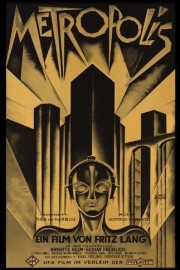The Complete Metropolis
Watching a broadcast of “The Complete Metropolis,” the recently-released restoration of Fritz Lang’s 1927 masterpiece, it’s hard to imagine the film looking or sounding better than it does now. The picture is crisp; the score (an original score by Gottfried Huppertz that long went unmarried to the film) is lush and brilliant; and the story (by Thea von Harbou) has finally been restored to the breadth and scope it was at in the film’s premiere 83 years ago in Germany. Long truncated by censors and commercial concerns, this is the fourth length I’ve watched “Metropolis” at over the years, and though the film has always been difficult to endure in terms of pacing (even at its shortest lengths), one cannot discount Lang’s visual command in looking at the film and its lasting effect.
The story should be familiar to many followers of science-fiction over the years: the son of industrial leader Joh Frederson discovers the inner workings of this futuristic society when a young woman (Maria) brings a group of kids from the underground city (where inhabitants work long hours keeping the machinery of Metropolis running smoothly as the upper-class go about their work and play), and begins Freder’s mission to bring the working class and the privileged together. This is the structure of the film’s tale, but Lang and von Harbou have deeper ideas, especially in the introduction of Rotwang (Rudolf Klein-Rogge), a mad scientist who has been working on a robot that would allow Frederson (Alfred Abel) to replace the working class with a machine workforce that would never tire, and never need to be paid– more for the citizens above. To call Lang’s film prescient of modern times is a gross understatement; even if it hadn’t inspired sci-fi classics like “Dark City,” “Blade Runner,” “2001: A Space Odyssey,” “The Matrix” and “Minority Report” (to say nothing of a 2002 Anime/Manga riff on the same story), the film’s influence on modern industrialism would be as clear as the film’s visuals are in this restoration.
“Metropolis” has had a long and intriguing history. The German director Lang was a dominating and exacting filmmaker; stories like actually flooding some of this film’s underground sets and setting fires all around Brigitte Helm (who played Maria in both human and robot form) during a mob scene make Kubrick look as gentle as Spielberg as a director. When the film premiered in 1927, it ran approximately 153 minutes. Not long after this debut, both in Germany and in preparation for its American debut, the film was cut to a more reasonable length for theatrical presentations at the time. Over the years, “Metropolis” was cut again to roughly 85 minutes, which for a long time was roughly the only length the film was available. Eventually, the film got back to a length of 124 minutes for a 2001 DVD restoration, which not only incorporated the original score for the first time since its premiere but also put title cards in place describing scenes still missing, and long thought lost. In 2008, however, a print was discovered in Buenos Aries that restored the film back to its premiere length, featuring scenes that hadn’t been seen since 1927. These scenes have been restored as best as possible, and reintegrated back into the new cut of the film that made its theatrical debut in April 2010 before finding its way onto DVD in November.
Is the film worthy of such effort? Without question. Long has it been one of the standard-bearers of its genre (and the silent era), both in influence and scope, and time (and the latest additions to the film) have only deepened the film’s impact. We learn of subplots than went missing but now throw previous storylines into focus, like Freder (Gustav Frohlich) switching places with a worker, who enjoys the good life above; and the antagonism between Frederson and Rotwang, who uses Frederson’s request to create a robot version of Maria (who wants to lead the workers in gaining the freedom they have been forbidden) as revenge for stealing the woman they both loved. We also get a larger look at the city itself, from its Olympian stadium to the “red light district” where “The Thin Man” (whom Frederson hired to follow his son) follows the worker Freder traded places with to a sacred religious building housing visual representations of the Seven Deadly Sins. Watching the film in its entirety now, one can see how provocative the film was then (and still is); its truncation was almost inevitable. But that provocation leads to a truly powerful example of what cinema is capable of.
So many great and memorable moments and images: the machines below Metropolis, whose logic is unknown, but impact on our visual memory is indelible; the evil Rotwang, and his chasing of the real Maria in the catacombs; the grand sets above ground, with a fully-realized glimpse of a world that would inspire many more in the years to come; the evil Maria’s seductive leading of the workers to revolt; the visuals that accompany the real Maria’s story about the Tower of Babel; the pleasure garden where we first meet Freder; the robot’s iconic transformation into Maria; and the iconic quote that gets at the heart of the film, “The mediator between the hands and the head has always been the heart.” Other films since have had more heart, but the hands and heads that created “Metropolis” are to be commended for their lasting contribution to what cinema is capable of. I can think of no greater tribute to them as this beautifully restored, nearly complete vision of what they worked towards, now available for generations to come.










